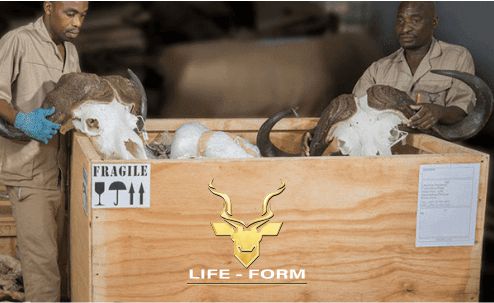
The trophies you bring back from your South African or African hunting safaris, are an important memento of your successful hunt.
On a typical organised hunting safari, skilled skinners and trackers will properly field prepare your trophies by skinning, tagging, and salting them once you have harvested them.
Following this, the taxidermist of your choice will co-ordinate the collection of the trophies after the Safari is completed. Once your trophies has been mounted on game pedestals, it’s important to ensure that it is safely shipped to your home to ensure that your hard-earned memento is preserved for years to come.
Here, we take a closer look at the process of taking your hunting trophy home.
Step one: the trophy is mounted at the taxidermist
Before the mounting process, your trophies are added to the taxidermist’s registry after being checked against the PH register upon collection. Upon delivery at the taxidermy, the booking-in process ensures that each trophy item is inspected, measured and metal tagged with a unique number which is assigned to each client. The allocated order number will serve as reference throughout the taxidermy process. This will also secure each trophy to its rightful owner and will be linked to all export documentation for ease of shipment.
In order to ensure that all skins dry out correctly, they are treated to a salt-action for at least 30 days. Then, they are treated with insecticides that have been deemed acceptable by the South African State Veterinary Services (Department of Agriculture).
The taxidermist will leave all skulls, horns, and bones out in the sun for at least a week to dry out naturally. The next step, mandated by the State Veterinary Services (DA) rules, is to boil them in a special solution. Afterwards, the flesh and sinews are removed from the skulls and bones.
A bleaching solution of Hydrogen Peroxide is then applied to the skulls, horns, and bones in accordance with State Veterinary Services (Department of Agriculture) rules, which kills any remaining germs in the skulls and removes any surplus oils from the bones. Skulls and bones are then dried in the sun before being safely stored.
Step two: the packaging and delivery process
Depending on the country of destinations requires, all hides and skulls may need to be packaged in transparent plastic, after which they must be prominently labelled.
If you choose to have your mounts done by a South African taxidermist, you may expect to wait anywhere from 9 months to a year for them to be delivered to your door in an approved plywood crate, custom made to secure your trophies for the journey abroad (with the horns removed, if necessary, to facilitate transportation).
Many hunters opt for this route despite the higher freight costs because having their trophies mounted by a South African taxidermist can save them up to 40%. It is important to see the results of this option in person before committing to it.
Shipping costs to take note of
- Flights to and from South Africa
- All costs associated with transporting your trophies from South Africa to the nearest port in your home nation.
- Receiving institution fees for clearing. A broker will pick up your trophies at the airport and see to it that they are processed by the US Department of Agriculture and the US Fish and Wildlife Service. Get a broker that can clear your consignment as close to your house or taxidermist as possible.
- Especially if they are valuable, you should insure your trophies. In most cases, insurance will cost one percent of the total worth of the awards.
Interesting Related Article: “Must Have Hunting Gear – A Guide”
